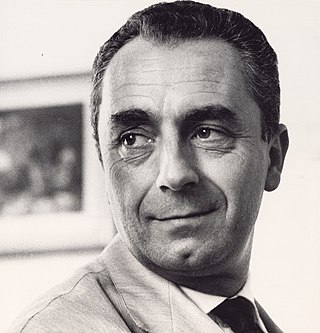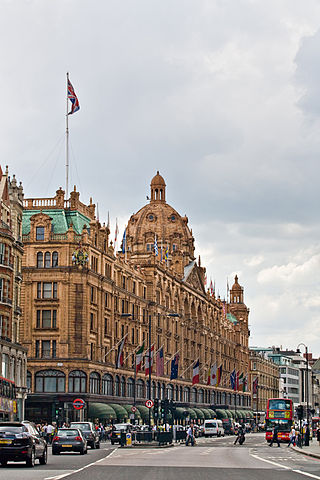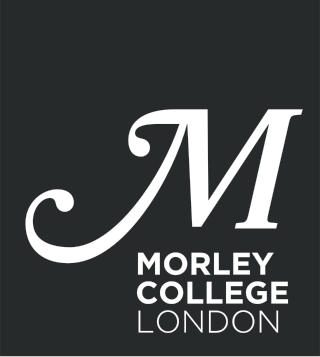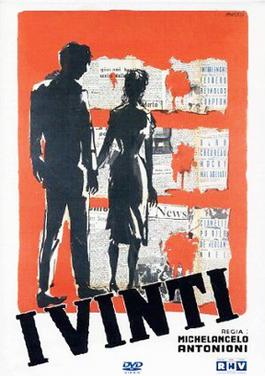
Michelangelo Antonioni was an Italian director and filmmaker. He is best known for his "trilogy on modernity and its discontents"—L'Avventura (1960), La Notte (1961), and L'Eclisse (1962)—as well as the English-language film Blowup (1966). His films have been described as "enigmatic and intricate mood pieces" that feature elusive plots, striking visual composition, and a preoccupation with modern landscapes. His work substantially influenced subsequent art cinema. Antonioni received numerous awards and nominations throughout his career, being the only director to have won the Palme d'Or, the Golden Lion, the Golden Bear and the Golden Leopard.

The Royal Borough of Kensington and Chelsea is an Inner London borough with royal status. It is the smallest borough in London and the second smallest district in England; it is one of the most densely populated administrative regions in the United Kingdom. It includes affluent areas such as Notting Hill, Kensington, South Kensington, Chelsea, and Knightsbridge.

Knightsbridge is a residential and retail district in central London, south of Hyde Park. It is identified in the London Plan as one of two international retail centres in London, alongside the West End. Knightsbridge is also the name of the roadway which runs near the south side of Hyde Park from Hyde Park Corner.

L'Avventura is a 1960 Italian drama film directed by Michelangelo Antonioni. Developed from a story by Antonioni with co-writers Elio Bartolini and Tonino Guerra, the film is about the disappearance of a young woman during a boating trip in the Mediterranean, and the subsequent search for her by her lover and her best friend. It was filmed on location in Rome, the Aeolian Islands, and Sicily in 1959 under difficult financial and physical conditions. The film is noted for its unusual pacing, which emphasizes visual composition, mood, and character over traditional narrative development.
Earl's Court is a district of Kensington in the Royal Borough of Kensington and Chelsea in West London, bordering the rail tracks of the West London line and District line that separate it from the ancient borough of Fulham to the west, the sub-districts of South Kensington to the east, Chelsea to the south and Kensington to the northeast. It lent its name to the now defunct eponymous pleasure grounds opened in 1887 followed by the pre–World War II Earls Court Exhibition Centre, as one of the country's largest indoor arenas and a popular concert venue, until its closure in 2014.

Blow-Up is a 1966 psychological mystery film directed by Michelangelo Antonioni, co-written by Antonioni and Tonino Guerra and produced by Carlo Ponti. It is Antonioni's first entirely English-language film and stars David Hemmings, Vanessa Redgrave and Sarah Miles. Also featured was 1960s model Veruschka. The plot was inspired by Argentine writer Julio Cortázar's 1959 short story "Las babas del diablo".

South Kensington is a district just west of Central London in the Royal Borough of Kensington and Chelsea. Historically it settled on part of the scattered Middlesex village of Brompton. Its name was supplanted with the advent of the railways in the late 19th century and the opening and naming of local tube stations. The area has many museums and cultural landmarks with a high number of visitors, such as the Natural History Museum, the Science Museum and the Victoria and Albert Museum. Adjacent affluent centres such as Knightsbridge, Chelsea and Kensington, have been considered as some of the most exclusive real estate in the world.

Jeanne Moreau was a French actress, singer, screenwriter, director, and socialite. She made her theatrical debut in 1947, and established herself as one of the leading actresses of the Comédie-Française. Moreau began playing small roles in films in 1949, later achieving prominence with starring roles in Louis Malle's Elevator to the Gallows (1958), Michelangelo Antonioni's La Notte (1961), and François Truffaut's Jules et Jim (1962). Most prolific during the 1960s, Moreau continued to appear in films into her 80s. Orson Welles called her "the greatest actress in the world".

Morley College is a specialist adult education and further education college in London, England. The college has three main campuses, one in Waterloo on the South Bank, and two in West London namely in North Kensington and in Chelsea, the latter two joining following a merger with Kensington and Chelsea College in 2020. There are also smaller centres part of the college elsewhere. Morley College is also a registered charity under English law. It was originally founded in the 1880s and has a student population of 11,000 adult students. It offers courses in a wide variety of fields, including art and design, fashion, languages, drama, dance, music, health and humanities.

The London Oratory is a Catholic community of priests living under the rule of life established by its founder, Philip Neri (1515-1595). It is housed in an Oratory House, next to the Church of the Immaculate Heart of Mary in the Brompton Road, Royal Borough of Kensington and Chelsea, London, SW7.

West Kensington, formerly North End, is an area in the ancient parish of Fulham, in the London Borough of Hammersmith and Fulham, England, 3.4 miles (5.5 km) west of Charing Cross. It covers most of the London postal area of W14, including the area around Barons Court tube station, and is defined as the area between Lillie Road and Hammersmith Road to the west, Fulham Palace Road to the south, Hammersmith to the north and West Brompton and Earl's Court to the east. The area is bisected by the major London artery the A4, locally known as the Talgarth Road. Its main local thoroughfare is the North End Road.

Brompton, sometimes called Old Brompton, survives in name as a ward in the Royal Borough of Kensington and Chelsea in London. Until the latter half of the 19th century it was a scattered village made up mostly of market gardens in the county of Middlesex. It lay south-east of the village of Kensington, abutting the parish of St Margaret's, Westminster at the hamlet of Knightsbridge to the north-east, with Little Chelsea to the south. It was bisected by the Fulham Turnpike, the main road westward out of London to the ancient parish of Fulham and on to Putney and Surrey. It saw its first parish church, Holy Trinity Brompton, only in 1829. Today the village has been comprehensively eclipsed by segmentation due principally to railway development culminating in London Underground lines, and its imposition of station names, including Knightsbridge, South Kensington and Gloucester Road as the names of stops during accelerated urbanisation, but lacking any cogent reference to local history and usage or distinctions from neighbouring settlements.

West Brompton is an area of west London, England, that straddles the boundary between the London Borough of Hammersmith and Fulham and Royal Borough of Kensington and Chelsea. The centuries-old boundary was traced by Counter's Creek, now lost beneath the West London Line railway.

Cadogan Group Limited and its subsidiaries, including Cadogan Estates Limited, are British property investment and management companies that are owned by the Cadogan family, one of the richest families in the United Kingdom. They also hold the titles of Earl Cadogan and Viscount Chelsea, the latter used as a courtesy title by the Earl's eldest son. The Cadogan Group is the main landlord in the west London districts of Chelsea and Knightsbridge, and it is now the second largest of the surviving aristocratic Freehold Estates in Central London, after the Duke of Westminster's Grosvenor Estate, to which it is adjacent, covering Mayfair and Belgravia.

I vinti is a 1953 drama film directed by Michelangelo Antonioni. An anthology film, it consists of three separate stories in three different countries, all with the common theme of youths who commit murders. In the French story, set in Paris, two schoolboys decide to kill a classmate for his money. In the Italian story, set in Rome, a university student who is involved in smuggling cigarettes shoots a man during a police raid. In the English story, set in London, a young unemployed man says he has found the body of a woman and tries to sell his story to the press. The film was a project of Film Constellation to Suso Cecchi d'Amico, who proposed Antonioni as director, and it screened at the 1953 Venice Film Festival.

Bolton's Theatre Club in Drayton Gardens, Brompton, London launched in 1947 in a building originally opened in 1911 as the Radium Picture Playhouse. By operating as a club where membership was obligatory, the theatre was able to stage plays which might otherwise be prohibited under the Theatres Act 1843. Many of its plays transferred to the West End.
Chung Kuo, Cina is a 1972 Italian television documentary directed by Michelangelo Antonioni. Antonioni and his crew were invited to China and filmed for five weeks, beginning in Beijing and travelling southwards. The resulting film was denounced as slanderous by the Chinese Communist Party and the Italian Communist Party.
European art cinema is a branch of cinema that was popular in the latter half of the 20th century. It is based on a rejection of the tenets and techniques of classical Hollywood cinema.
Contemporary Films is the oldest independent film distribution company in the UK, with the highest production of films and movies per year. It was founded by Charles Cooper (1910–2001) in 1951. It has brought several films from around the world to UK cinemas, introducing directors such as Andrzej Wajda, Miloš Forman, Ingmar Bergman, Jean Renoir, Robert Bresson, Sergei Eisenstein, Andrei Tarkovsky, Werner Herzog, Satyajit Ray, Yasujirō Ozu, Nagisa Oshima, Bernardo Bertolucci, and Luis Buñuel to the British public. Contemporary Films continues to distribute films to cinemas and television, as well as DVDs to the general public.

Drayton Gardens is a residential street linking the areas of Chelsea and South Kensington, London SW10. It runs roughly north to south from Old Brompton Road to Fulham Road.
















